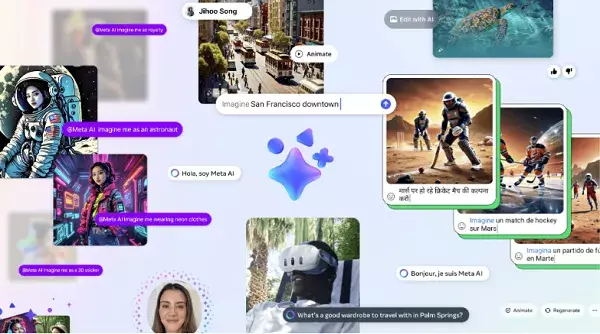Meta is pressing forward with its AI development plan by extending the reach of its Meta AI chatbot to seven additional languages. The regions gaining access to the chatbot include Argentina, Chile, Colombia, Ecuador, Mexico, Peru, and Cameroon. Users can now interact with the bot in seven new languages, namely French, German, Hindi, Hindi-Romanized Script, Italian, Portuguese, and Spanish. Despite mixed reviews, Meta CEO Mark Zuckerberg remains optimistic about the chatbot’s future, aiming to make it the most widely used AI assistant globally.
It’s worth noting that Meta’s massive user base, spread across platforms like Facebook, WhatsApp, and IG, contributes significantly to the bot’s exposure and potential usage. However, it remains debatable whether the bot’s popularity stems from its utility or sheer ubiquity among users.
In addition to broadening language support, Meta is introducing new creative functionalities to its chatbot. Users can now generate AI images of themselves directly within the chat stream using prompts like ‘Imagine me surfing’ or ‘Imagine me on a beach vacation.’ This feature, reminiscent of Snapchat’s ‘Dreams’ functionality, offers users a fun way to experiment with AI-generated content.
Furthermore, Meta is also enhancing its editing tools for AI-generated images, allowing users to customize and fine-tune their creations in real-time. This capability enables users to add or remove objects, make adjustments, and refine their imagined images with ease. The upcoming ‘Edit with AI’ button promises further refinements and enhancements to this feature, enhancing the overall user experience.
While Meta’s AI advancements showcase innovation and creativity, concerns arise regarding the potential dilution of the human element in social interactions. By integrating AI content more extensively into its platforms, Meta risks overshadowing the authentic social experiences that users seek on social media. The shift towards encouraging bot usage among users raises questions about the true essence of interactive communities and the balance between human and AI-generated content.
Meta’s latest option, allowing users to select different AI models for various tasks within the app, adds a technical dimension to the user experience. While this feature offers increased flexibility and functionality, the accessibility of more powerful AI models may not see widespread adoption due to its technical nature.
A significant development in Meta’s AI roadmap involves the integration of Meta AI with Virtual Reality (VR) technology. By introducing Meta AI in VR as a beta feature for selected users in North America, the company aims to revolutionize VR experiences. This integration not only enables hands-free control and real-time information access but also paves the way for immersive VR content creation using AI tools.
The potential for Meta AI to simplify VR development processes and create immersive experiences based on text prompts holds promise for the future of digital engagement. As Meta aligns its AI tools with VR capabilities, users are likely to shift towards more interactive and experiential forms of digital interaction, setting the stage for future innovations in AI and VR integration.
While Meta’s current AI developments may raise concerns about the evolving nature of digital interactions, they represent a stepping stone towards a future where AI seamlessly integrates with everyday experiences. As users adapt to AI-based chat interactions and explore AI-generated content, the stage is set for a new era of digital innovation and interaction, paving the way for more immersive and personalized user experiences in the virtual realm.


Leave a Reply